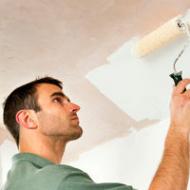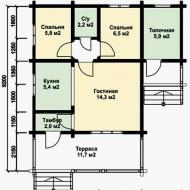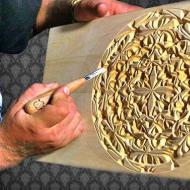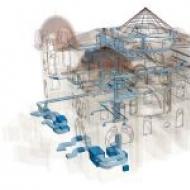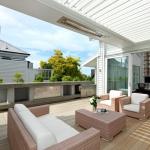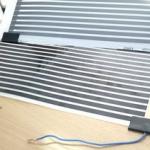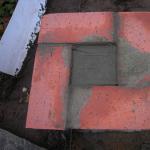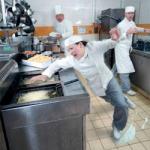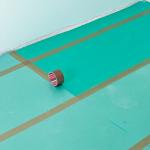
How to make a child's handprint. Do-it-yourself casts of arms and legs
What to give grandma for March 8? Gifts from grandchildren are the most expensive, so grandmothers will be happy with everything. It is especially important that the baby takes part in the preparation of the gift. Here is one of these gifts today I want to offer and show how to make salt dough for baby footprints.
When I saw this idea for the first time, it captivated me. No, it is not new, but the simplicity of its implementation immediately prompted the desire to repeat it to myself. Hope it inspires you too.
Necessary materials
- salt- 1 glass
- flour- 1 glass
- water- 1/2 cup
- rolling pin for rolling dough
- kitchen knife
- acrylic paint
- tassel for drawing
How to make footprints on salt dough
1. Cooking salt dough
Mixing salt (1 cup), flour (1 cup) and water (1/2 cup). Mix everything well to get a homogeneous dough.
The child can also help in this process. With his little fingers, he will really like to interfere with the dough.
2. Cut out the heart
Roll out the dough with a rolling pin to make plate about 1.5-2 cm thick.

Cut out a heart
Put the heart on a baking sheet. I also covered the baking paper, but because of this, the bottom of the heart turned out to be uneven. It would probably be better to just put it on a baking sheet without paper.
I would be glad to hear your comments on this if you repeat the idea.
3. Footprints
With bare children's feet we make an imprint on the heart.

footprints
We got it right the first time. Although the child practically does not stand still, but those seconds that we need to leave an imprint, he stood still, enthusiastically watching the process.
Using a spoon, make an inscription on the heart.
4. Baking in the oven
Preheating the oven up to 100 degrees and put a baking sheet with the print of the legs for baking for 3 hours.
5. Paint the imprint of the legs
After I took the print out of the oven, I let it cool down for a while and then carefully peel off the baking paper.
The original recipe says that you can paint a heart almost immediately, but I have it a couple more days lay down.
For painting I took acrylic paint. She dries quickly.

Paint the print of the legs
First I painted one side, and at the end of the day I painted the other.

Paint the print of the legs
You can also include a child in this process. Even if it turns out less accurately, but the main thing is the process. I haven't decided on this yet. We are now at an age when a child wants to do everything himself, he would not let me help, and at some point he himself could simply drop and break our imprint.
I am very pleased with the result. Now just need to find deep photo frame to put our present in it.
I didn't make a hole for hanging. The heart turned out to be not very light and could simply not withstand its weight, fall and break.
Please leave your feedback or comment. I'm very interested in your opinion!
Time does not stand still, so it is important to remember every little thing about such an important thing as the childhood of your beloved baby. Many parents have a tradition of making prints of a child's hand or foot. But all the old methods are already outdated: for them it was necessary to prepare a solution on their own, which was far from always obtained, and the quality of such products left much to be desired. Over time, they began to crumble and burst.
Of course, there are special workshops that are ready to help you. Such services are very expensive and are only in large cities.
But in the modern world, everything is easier. There is a wonderful alternative to all methods: now you can make casts using a special children's kit without leaving your home.
What is a set?
The Mold Frame is the first set to create with your child to create lasting memories of tiny hands and feet. The set consists of a mass for modeling, an original panel for pleasant wishes, satin and adhesive tapes.
The set is for children, therefore it is presented in two versions with a unique design:
- for a girl - in pink;
- for a boy - in blue.
It is also important that the use of a special set is completely safe for health, since it does not contain harmful components for the skin. The set will be an unusual and stylish gift that you will surprise people with. These things are still new and not everyone knows about them. Do not be afraid to make original surprises. For example, both parents for the birth of a child, and grandparents for the first little anniversary of the baby. This decoration of the children's room will be a great addition to the interior.
To make a cast frame, you do not need to have any experience, the ability of a sculptor, or attend special courses. It is enough to carefully read the instructions, which are detailed on the kit.
Mode of application
The mass for modeling is completely ready for use, for convenience, it should be kneaded by hands for 30 seconds and rolled out into a 2 cm thick layer. It remains only to attach a tiny hand or foot of the baby. For a successful result, you do not need to rush, however, it should be remembered that the mass dries quickly enough in air.
To create an impression of a hand, follow these steps:
- Press your palm against the material so that a uniform outline remains. But not too much, be calm and patient, even if the child is mischievous. Do not be alarmed if the cast of the pen did not work out the first time: the mass can be re-kneaded and the creative process repeated.
- Next, you should leave the mass in the open air until it solidifies completely (this will take no more than an hour), if desired, the resulting panel can be painted when everything is dry.
- After sculpting, simply wipe your hands with a damp cloth. The mass does not leave marks or discomfort on the skin, so there is no reason to worry about the health of the baby.
Making an impression of the leg will require a little more effort:
- This will require 2 people if the baby is still very small and does not stand on its own. Ask the child to raise and gently, fixing his lower leg with his hand, lower it onto the modeling mass.
- Make sure that the child does not move his leg. If necessary, correct the contours with your fingers.
- Next, wipe the skin with a napkin and wait for the material to dry completely. It remains to insert the cast of the leg into the frame from the set.


Kit Benefits
Compared with a number of its analogues, this tool has the following advantages:
- for him, it is not necessary to dilute the solution, soiling the house and exposing the baby to harmful components that are part of the building materials;
- no special skills required;
- the print of the handle or leg is ready in seconds;
- there is no need to buy additional parts - everything is already in the kit;
- value for money.
How to successfully make a cast?
In order for the cast of the handle or leg to turn out the way you want the first time, you need to follow some steps:
- Take care of the calm state and mood of the baby. Prepare a toy or an interesting cartoon to distract him if you don't want to. But it happens that your fidget flatly refuses to participate in creativity. Just try to do it in a playful way or when he is sleeping. Casts of the whole family would also be a good idea.
- Make it a tradition to make these memory frames as your baby grows, for example, in the first month of life and on the first birthday. Then in a few years the already grown up kid will study them with interest. Yes, and you will be surprised when yesterday's baby managed to grow up.
In the set there is a special panel for wishes. Ask close family and friends to leave a few sweet wishes for the future. Over time, it will be pleasant to reread them, gathering with the family. The panel has special holes for ribbons, so it will not be difficult to hang it on the wall.
Babies in their first year of life grow so fast that their parents don't even have time to look back. But you really want to capture in your memory the moments when the baby is very small. The way out of the situation is casts of arms and legs. Buying a ready-made kit for their manufacture is now not difficult.
However, the price of such kits is often surprising, and the creative components included in the composition seriously limit the imagination. How realistic is it to make casts of arms and legs with your own hands, using improvised means? It turns out that the procedure is quite simple, and the materials will require quite a bit!
Plaster casts
How to make casts of arms and legs with your own hands using plaster? You need to take plasticine, you can even use an old one, heat it in a microwave oven and form a cake so that a foot or palm print fits on it.
Then we make an imprint on the cake. If the first time does not work out, then you just need to re-heat the mass. To make the print clearer and deeper, when pressing, fix the edges of the cake so that they do not diverge to the sides.
 It is convenient to use a certain form with sides for this. After obtaining an acceptable result, the cast is placed in a freezer to harden. We breed gypsum for sculptural works (can be purchased at an art store) in accordance with the instructions and additionally add a little PVA glue, pour the resulting mass into cakes with prints, leave for a while to harden.
It is convenient to use a certain form with sides for this. After obtaining an acceptable result, the cast is placed in a freezer to harden. We breed gypsum for sculptural works (can be purchased at an art store) in accordance with the instructions and additionally add a little PVA glue, pour the resulting mass into cakes with prints, leave for a while to harden.
When the gypsum hardens, the resulting casts are carefully cleaned of plasticine and left for about a day for final drying. Then you should lightly walk on them with sandpaper, removing roughness and irregularities. This should be done very carefully so as not to crumble the finished product. From above it is necessary to apply paint in several layers.
The most popular options are bronze or metallic silver, but the choice of color is up to you. After drying, the casts of the arms and legs (by the way, made with your own hands) are ready! They can be placed in a deep frame, mounted on a stand or otherwise fit into the interior.
Casts of alabaster

The second, no less budgetary way with which you can make casts of arms and legs with your own hands is to use alabaster as a base. It is necessary to mix five glasses of flour, two and a half glasses of fine salt, a tube of baby cream, mix. Gradually add water, achieving the consistency of plasticine.
We make cakes of the required shape and make prints of the feet and hands. The casts are placed in the oven and dried at a low temperature until hardened. Lubricate the prints with petroleum jelly and fill with diluted alabaster, leave to dry.
After complete drying, carefully remove the casts from the mold using a nail file, file, other improvised means, give them a neat shape. After that, we cover the casts with paint of the desired color and let it dry.
We looked at two of the easiest ways to make casts of arms and legs with your own hands. As you can see, it is quite simple and accessible to parents. And the possibilities of further decoration are limited only by the range of products of the art store!
It can be a beautiful frame in a marine style for a boy, decorated with pebbles and shells, a flower arrangement for a girl. Or you can even make a cast of the pen every month and by the end of the year draw up an unusual panel, which will clearly show how quickly the baby grew during this period.
The most beautiful phenomenon created by nature is the birth of a child.
In the modern world, with the help of various types of equipment (camera, video camera), you can track the development of the baby from the very first day of life.
But many people want to look at their baby not only from photographs and videos. Therefore, they often order in studios the so-called copies of the arms and legs of a child - casts that can be made from almost any hardening material - gypsum, chocolate, wax, liquid glass and other materials.
But in this article we will focus on other types of casts - the so-called 3D casts. In another way, they are also called voluminous.
On the Internet you can find the very technology of their manufacture, but rarely where you will see information about their component composition. In this publication, we will reveal this secret to you.
So, to make a three-dimensional cast of a child's arms or legs, we need:
- gypsum (or other hardening material)
- alginate (sold in dental stores)
- plastic container
- water (36.6 degrees)
Before you start work, you need to put your child to sleep in a playpen or a baby cradle (if the little one is still small). This is necessary so that during the removal of the impression, he does not move the handle or leg.
Then we prepare the impression mass. To do this, select the right amount of alginate powder and water in accordance with 1.5 to 1.
Pour the alginate into the water (and not vice versa!) And stir with a mixer or a spoon. Just do it very quickly, as it freezes almost immediately.
Then we immerse the baby's handle (leg) in this mass, wait for solidification. Whether it has frozen or not, you can check with your finger - touch the surface of the mass - if it does not stick to your hands, then the solidification is over. As a result, it should look like rubber.
Now, very carefully, so as not to damage the impression mass, we take the child's limb out of it, and put it back to sleep under the supervision of a baby monitor or video baby monitor. We will get a kind of deepening.
The next step is to prepare a solution of gypsum and water. Pour the gypsum into the water (and not vice versa!) And stir it to the consistency of thick sour cream and fill the resulting cast with this solution. We are waiting for a day. Then we carefully cut the alginate along the edges of the container with a knife, turn it over and make an incision on the mass in order to pull out the resulting cast.
That's all. As they say, everything ingenious is simple. Now the voluminous cast of your crumbs will be preserved for life and constantly remind you of the moments of his childhood.
The company "Chameleon" offers to try an interesting business: Making compositions with casts of baby's arms and legs, 3D copies of newlyweds' hands, commemorative medals with handprints, casts of paws of pets.
What it looks like:

Formats
This business can be done at home or open a point in a large shopping center, offering a wider range of services.
Format "House"
Under the condition of working at home, orders are accepted as follows. The client makes a phone call. The time and date of arrival of a specialist at home are discussed. At the appointed time at the client’s home, the necessary blinds are removed, the baby is photographed, and the design option is discussed. All conditions are recorded in the order form. It also reflects the amount of prepayment for the composition, a sales receipt is issued. The master takes away the casts and all the rest of the work on filling and further designing the composition, and spends it at home.
The finished work is delivered to the client at home or he independently picks it up at the place indicated by the master, if necessary, pays the remaining amount.
Format "Studio"
Subject to work in the studio or the availability of retail space in the shopping center, orders are accepted there on the spot by the manager or by phone. Casts can be taken both in the studio and at the customer's home at his discretion. The advantage of going to the client's house is that such conditions are more comfortable for the baby, there are familiar toys and environment nearby.
As you can see, the business is quite simple, it does not require special knowledge, significant investments, all you need is a desire, and in everything else we will help you, from technology to business advice.
The target audience
Potential buyers are: loving parents, grandparents, godparents. Families with average income and above average. The age of the main client is from 23-45 years.
Ways to promote
The target audience is informed about this service by advertising in: maternity hospitals, kindergartens (nursery groups), photo salons and photo studios, children's goods stores, registry offices. The main thing in this business at the beginning of work is to declare yourself with the help of advertising in the places listed above, placing ready-made sample compositions in places where potential customers congregate. In the future, "word of mouth" gives a good effect.
Key Features
The main features and benefits are:
- lack of license and special permits
- minimum investment
- high profitability
- quick payback
- opportunity to showcase your creativity
- great job for mums on maternity leave
- Office is not required, work from home is possible
- almost no seasonality
Technology
The technology for making casts of pens is quite simple.
- A very plastic, soft reusable material is used, which allows even the smallest children to take impressions from birth.
- The process of making an impression takes several minutes. After that, the master takes away the casts and fills them with gypsum mortar at the workplace, after the gypsum has hardened, the product is processed if there are defects and left for further drying.
- While the casts are drying, you can process the photo in the program.
- Next, the composition is assembled - all elements are glued to the base and inserted into the frame.
The time spent on making one fully designed composition is: 1 day, of which 12 hours for drying the casts (this process can be accelerated by drying the casts in the oven), immediately leaving to the client, processing the photo and printing it.

What equipment is required to start this business
Basic equipment
No special equipment is required, and what is listed is already in almost every home.
The printer in this case is not required, because.
in any case, printing of large formats of photographs for compositions is carried out in a photo salon.
For work, plastic containers are required in the form of disposable plates for taking impressions, 1.5-3 liter containers for 3D copies of hands, a mixer or a mixing spoon.
How much money do you need to get started?
- Basic equipment: 25,000
- Accessory: no
- Purchase of raw materials and consumables 1,500 rubles.
- Buying a business package - from 5300 rubles.
- The cost of an advertising company - from 3000 rubles.
- Total: 34,800 rubles.
How much can you earn on this?
The cost of making one cast using reusable material is 10 rubles, including plaster and paint.
Baguette frame with glass (framing workshop) - 500 rubles.
We create casts of arms and legs ourselves using alginate gel and gypsum
and above, depending on the baguette option
Composition layout:
- photo collage and decorative elements — 100 rubles.
- decoration for a frame without glass - 100-200 rubles.
The total cost of the composition is 600-700 rubles.
Retail price
The price of a 30x40 format composition with two children's casts is 2,000-5,000 rubles.
As a result, the income from one composition is 1300 - 3500 rubles.
According to practice, for a city with a population of 150 thousand people, the average number of orders per month is 20 pieces, i.e. net profit of about 30 -35,000 rubles. (provided that you are running a business at home). Return on investment: 1.5 -2 months
The offer of the company "Chameleon"
By purchasing a business package from us, you get at your disposal a detailed guide to creating your own impression business, in which we transfer all our experience and knowledge to you.
Depending on the type of business package, you get a set of materials and a personal website to start your new business.
Plus, you will be provided with free consulting support on all issues of running this business and without time limits.
December 2015 update
Another option for opening a studio for making casts of arms and legs is offered by the company "Present Day" (investments from 30,000 rubles). You can read the terms of the franchise or leave a request below for detailed information about the proposed business model.
Contact details
- Company "Chameleon"
- mob. 8 913 792 7363, 906 965 6423
- Skype: hameleon2108
- Email: [email protected]
Questions and answers on the topic
view all (1)
We make casts of children's arms and legs with our own hands!
Home — Articles — We make molds of children's hands and feet with our own hands!
Hello dear readers, finally I am ripe for a new article!
A year and a half has passed since the last inspiration!
A lot of new things have happened in my life, the most important thing is that my son, Leonid, my second child, was born (in January 2014)!
He is now 6.5 months old. And I again started a business with casts!
How to make a mold of the arms and legs with your own hands from plaster? We answer: "Very simple!"
There are tons of kits for making them in stores, and there are a lot of different tips on the Internet on how to make them!
In 2011, 3 years ago, when I was making casts of Danochka's arms and legs, I first bought a ready-made set.
How to make a 3d cast of a child's arms and legs at home
I did everything according to the instructions. She diluted the mixture, put the sleeping child’s hand into a plate, and my Danulya took it and woke up and knocked over all this liquid on me! While I was washing, the second jar of gel dried up. Conclusion: I threw money away!
Then I got into my favorite Internet, and saw a lot of recipes for making children's casts from gypsum.
I want to tell you the simplest and easiest way to make casts of your favorite arms and legs, which I liked the most!
To make children's casts you will need: 
For test:
- half a glass of water
- two tablespoons of sunflower oil,
(oil is needed to make the dough more elastic)
- one glass of flour
- one glass of salt
(preferably fine, salt is needed so that the dough is “obedient”, so that it keeps its shape better)
The volume of my glass is 150 milliliters.
To make the casts themselves:
- gypsum,
- water.
Where can I get plaster for making children's casts?
1. You can buy on the construction market.
2. You can buy any children's kit for creativity, for example, the Sculptor kit.
I have had this set since 2011 🙂
First we make the dough.
In a bowl, mix salt and flour, pour in oil and water, mix everything.
The dough should be tight! If the dough is runny, add more flour.
Divide the dough in half and roll it out with your hands.
It is necessary to get two small round, but thick (2-3 cm) cakes, so that the cast is more voluminous. 
We take a little one, make prints of the legs and handles!
Making a baby footprint 
Making an imprint of a child's hand 
For the first time with Dana, I made the right arm and the left leg.
The second time with Leonid, I made the right arm and right leg.
It is better to do as the first time, for example, the left arm and right leg or vice versa.
I think it looks so beautiful!
Next, take a disposable glass, pour water, pour gypsum and mix everything.
I don’t specifically write the proportions of water and gypsum, since I made liquid gypsum “by eye”.
The consistency should be like sour cream or kefir.
We pour liquid plaster into our children's prints, and wait. 
When the plaster has hardened, remove the dough and our casts are ready! 
The rest of the dough is easily removed with ordinary water.
Baby molds are ready! 
It remains to decorate them!
You can color the casts as you like, I took pink and silver nail polish!
First, she painted the children's casts with pink, and then with silver varnish.
Here's what happened. 
Then I found a beautiful frame on the Internet, added a photo of the child and signed the age - I printed the photo!
I bought a regular photo frame, put a photo, a pregnancy test, a bracelet and a tag from the hospital!
I glued the finished children's casts, on double-sided tape, on glass!
So a beautiful frame with children's casts is ready for a long memory! 
You can add baby's first clothes, a pacifier, and more.
For comparison, I post a photo of my first frame with casts! 
Now we have this beauty at home: 
Children's casts can be made at any age, but to make it easier to attach them, it is better when they are still tiny.
The sooner you make casts, the easier it is to attach them to the photo frame!
Good luck with your creations!
P.S. : The only thing I didn't understand is how to remove air bubbles from plaster?
Small dots appear on the casts.
Maybe you need to stir longer?
Little children grow up quickly, and so you want to capture their tiny fingers and legs in memory. Casts of arms and legs made by parents can become quite a tangible thing. The manufacturing process is very simple, the materials are available, and the result will delight you for many years.
You will need:
- flour;
- salt;
- water;
- gypsum or alabaster;
- paint in a can;
- picture frame;
- liquid Nails;
- photograph of a child, jewelry.






The considered option allows you to make casts of arms and legs using improvised materials. To get three-dimensional casts, you can purchase ready-made kits with a gel filler.

